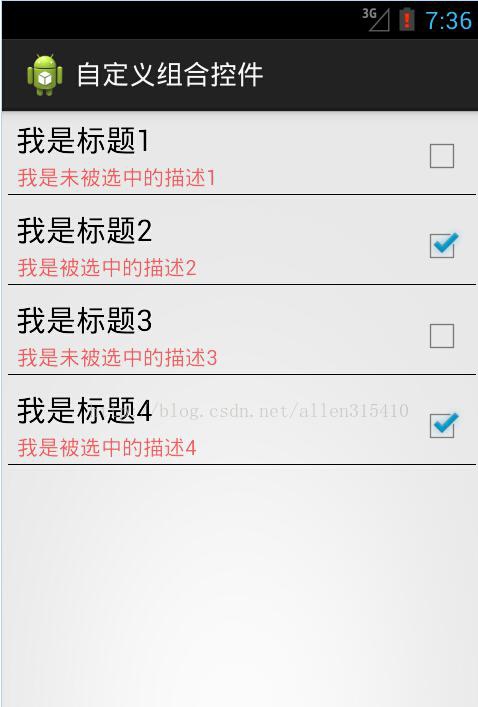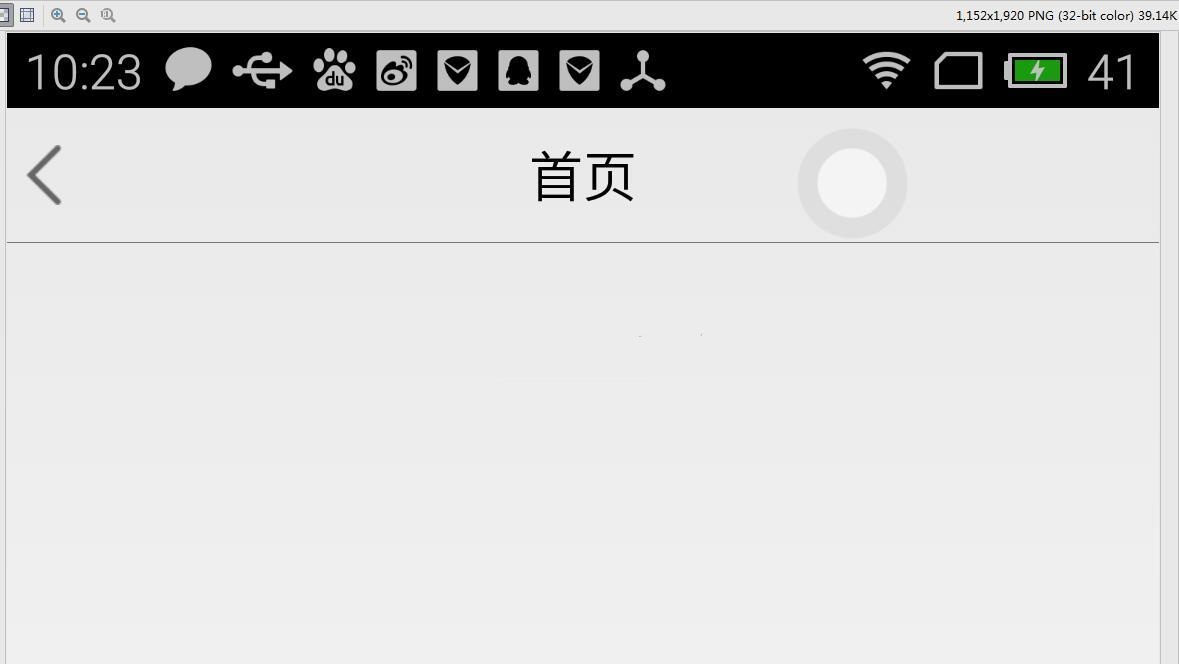編輯:關於Android編程
有很多情況下,我們只要運用好Android給我提供好的控件,經過布局巧妙的結合在一起,就是一個新的控件,我稱之為“自定義組合控件”。
那麼,這種自定義組合控件在什麼情況下用呢?或者大家在做項目時候會發現,某些布局會被重復的利用,同一個布局的XML代碼塊會被重復的復制黏貼多次,這樣會造成代碼結構混亂不說,代碼量也會增大,各種控件都需要在Java代碼中被申明和處理相應的邏輯,工作量著實不小,所以,必須要找到一個合理的“偷懶”的方式,開動腦經去怎麼簡化以上說的不必要的麻煩。下面看一張圖,就一個簡單的布局,我們就此圖來實現一個簡單的自定義組合控件。

從上面的圖來分析,我們可以看到,這個布局裡面是沒有“全新”的控件的,用的都是Android系統原生的控件。熟悉Android界面布局的人,肯定覺得這種布局真是小Case,太簡單了,分分鐘就可以寫完。於是下面就是某一個條目的布局代碼:
<!--?xml version=1.0 encoding=utf-8?--> <relativelayout android:background="@drawable/selector_blue" android:id="@+id/rl_show_address" android:layout_height="60dip" android:layout_width="match_parent" xmlns:android="http://schemas.android.com/apk/res/android"> <textview android:id="@+id/tv_title" android:layout_height="wrap_content" android:layout_marginleft="5dip" android:layout_margintop="1dip" android:layout_width="wrap_content" android:text="這是標題" android:textcolor="#000000" android:textsize="20sp"> <textview android:id="@+id/tv_desc" android:layout_below="@id/tv_title" android:layout_height="wrap_content" android:layout_marginleft="6dip" android:layout_margintop="1dip" android:layout_width="wrap_content" android:text="這是描述內容" android:textcolor="#99ff0000" android:textsize="14sp"> <checkbox android:clickable="false" android:focusable="false" android:id="@+id/cb_status" android:layout_alignparentright="true" android:layout_centervertical="true" android:layout_height="wrap_content" android:layout_width="wrap_content"> <!-- 加一條分割線 --> <view android:background="#000000/" android:layout_alignbottom="@id/cb_status" android:layout_alignparentbottom="true" android:layout_height="0.2dip" android:layout_margintop="7dip" android:layout_width="match_parent"> </view></checkbox></textview></textview></relativelayout>
可以看到,這種布局確實相當的簡單。但是,這時候產品經理告訴你,需求改了,我們需要在這個界面再加一個這樣的條目,於是你覺得,小意思,Ctrl+C,Ctrl+V,輕松搞定,然後改一下控件的id,在Java代碼中findviewbyid(id),加一段邏輯代碼,搞完收工。沒想到這時候產品又來了,需求改了,這裡需要加10個這樣的布局,於是你...誠然,這時候再Ctrl+C,Ctrl+V是不合適的,工作量就顯得很大了,即使你不嫌麻煩的話,照樣做了,你料不到產品會再來,那個給我刪掉幾個,那個再加上幾個,是不是要瘋了。
也許,我們可以相出一個偷懶的方法來呢。通過分析上面的布局,可以發現,布局上每一個子條目是不變的,布局完全一樣,唯一在變化的是,紅色的TextView上的文本隨著CheckBox的狀態再改變著,而這種變化,我們是否可以想辦法抽取到某個方法中呢,答案是肯定能的。我們可以將這種子條目的布局一次性封裝到一個Java類中,每次調用這個控件的時候,事先設定各種屬性數據即可,這裡涉及到了自定義屬性了。分析一下這個屬性集該怎麼定義,從上面的圖片可以看出,控件上需要設置的內容分別是,上面TextView的標題,還有下面TextView的描述信息,且描述信息是根據CheckBox的狀態發生改變的,所以這兩種狀態(true或false)都需要被定義到屬性集裡去,於是屬性集就有了。
在工程下的res/values目錄下,新建attrs.xml文件,定義如下屬性集:
<!--?xml version=1.0 encoding=utf-8?-->
<resources>
<declare-styleable name="combinationView">
</attr>
</attr>
</attr>
</declare-styleable>
</resources>
定義好了屬性集了,接下來我們就需要定義一個Java類,來渲染這段布局,解析這個屬性集,並且對象提供修改控件狀態的方法,已達到復用的效果。問題來了,我們定義的這個Java類需要繼承哪個類呢?在這裡,我們不必考慮View了,因為這裡不是全新自定義控件,不需要onMessure和onDraw去測量去畫一個視圖。那麼ViewGroup呢?我們也不必用這個類,因為這裡的布局是給定好的,不需要使用onLayout給子控件設置顯示的位置。那麼,該繼承什麼呢?我們可以想象一下ViewGroup的子類是不是可以呢?實現自定義控件的除了繼承View和ViewGroup之外,還可以直接繼承Android已有的控件進行修改,這個用面向對象的思想,應該不難想象吧。由於,該布局文件用的相對布局RelativeLayout,我們想當然可以自定義Java類去繼承這個RelativeLayout,RelativeLayout裡提供一些參數和方法方便我們去實現子控件的布局。但是,我們這裡直接在子控件布局已經寫好了,不需要使用RelativeLayout提供的參數和方法來布局了。所以,導致了,即使不去繼承RelativeLayout,而改成LinearLayout,FrameLayout...也是可以的,只要這個布局類是ViewGroup的子類就行。以下是這個自定義組合控件的實現代碼:
package com.example.combinationview;
import android.content.Context;
import android.util.AttributeSet;
import android.view.View;
import android.widget.CheckBox;
import android.widget.RelativeLayout;
import android.widget.TextView;
public class CombinationView extends RelativeLayout {
private TextView tv_title;
private TextView tv_desc;
private CheckBox cb_status;
// 命名空間,在引用這個自定義組件的時候,需要用到
private String namespace = http://schemas.android.com/apk/res/com.example.combinationview;
// 標題
private String title;
// 被選中的描述
private String desc_on;
// 未被選中的描述
private String desc_off;
public CombinationView(Context context, AttributeSet attrs) {
super(context, attrs);
// 將自定義組合控件的布局渲染成View
View view = View.inflate(context, R.layout.layout_combinationview, this);
tv_title = (TextView) view.findViewById(R.id.tv_title);
tv_desc = (TextView) view.findViewById(R.id.tv_desc);
cb_status = (CheckBox) view.findViewById(R.id.cb_status);
title = attrs.getAttributeValue(namespace, title);
desc_on = attrs.getAttributeValue(namespace, desc_on);
desc_off = attrs.getAttributeValue(namespace, desc_off);
System.out.println(title + : + desc_on + : + desc_off);
// 初始化到子控件
if (title != null) {
tv_title.setText(title);
}
if (desc_off != null) {
tv_desc.setText(desc_off);
}
}
/**
* 判斷是否被選中
*
* @return
*/
public boolean isChecked() {
return cb_status.isChecked();
}
/**
* 設置選中的狀態
*
* @param isChecked
*/
public void setChecked(boolean isChecked) {
cb_status.setChecked(isChecked);
if (isChecked) {
tv_desc.setText(desc_on);
} else {
tv_desc.setText(desc_off);
}
}
}
代碼很簡單,首先繼承RelativeLayout,復寫其構造方法,在構造方法中先渲染布局的視圖,然後讀取屬性集的屬性,將默認顯示的屬性顯示到布局上的子控件上即可。另外,還要對外提供一個判斷狀態的方法isChecked()來判斷該控件是否被選中了,提供一個設置狀態的方法setChecked(boolean),用來改變狀態。PS:為了驗證我上面的一段話,讀者可以將繼承RelativeLayout,改為繼承LinearLayout或者繼承FrameLayout,運行試試看,也是可以實現的。
下面是引用這個自定義組合控件的方法,首先需要在Activity的布局文件中定義出來:
<linearlayout android:layout_height="match_parent" android:layout_width="match_parent" android:orientation="vertical" xmlns:android="http://schemas.android.com/apk/res/android" xmlns:example="http://schemas.android.com/apk/res/com.example.combinationview"> <com.example.combinationview.combinationview android:id="@+id/cv_first" android:layout_height="wrap_content" android:layout_width="match_parent" example:desc_off="我是未被選中的描述1" example:desc_on="我是被選中的描述1" example:title="我是標題1"> </com.example.combinationview.combinationview> <com.example.combinationview.combinationview android:id="@+id/cv_second" android:layout_height="wrap_content" android:layout_width="match_parent" example:desc_off="我是未被選中的描述2" example:desc_on="我是被選中的描述2" example:title="我是標題2"> </com.example.combinationview.combinationview> <com.example.combinationview.combinationview android:id="@+id/cv_third" android:layout_height="wrap_content" android:layout_width="match_parent" example:desc_off="我是未被選中的描述3" example:desc_on="我是被選中的描述3" example:title="我是標題3"> </com.example.combinationview.combinationview> <com.example.combinationview.combinationview android:id="@+id/cv_fourth" android:layout_height="wrap_content" android:layout_width="match_parent" example:desc_off="我是未被選中的描述4" example:desc_on="我是被選中的描述4" example:title="我是標題4"> </com.example.combinationview.combinationview> </linearlayout>
首先在上面定義了四個自定義組合控件,大家可以看到,代碼精簡多了不是?!需要注意的地方:這裡引用了自定義的屬性集,所以在布局節點上必須要加上命名空間
xmlns:example=http://schemas.android.com/apk/res/com.example.combinationview
其中,example是命名空間的名稱,是任意取的,但是必須在控件中引用屬性的名稱一致,不然會報錯。後面的一串是標明屬性集的路徑,前半部分是固定的,最後一個“/”後面的內容必須是工程的包名,否則報錯。
下面是Activity裡面的業務邏輯代碼,沒什麼好說的
package com.example.combinationview;
import android.os.Bundle;
import android.view.View;
import android.view.View.OnClickListener;
import android.app.Activity;
public class MainActivity extends Activity implements OnClickListener {
private CombinationView cv_first;
private CombinationView cv_second;
private CombinationView cv_third;
private CombinationView cv_fourth;
@Override
protected void onCreate(Bundle savedInstanceState) {
super.onCreate(savedInstanceState);
setContentView(R.layout.activity_main);
cv_first = (CombinationView) findViewById(R.id.cv_first);
cv_second = (CombinationView) findViewById(R.id.cv_second);
cv_third = (CombinationView) findViewById(R.id.cv_third);
cv_fourth = (CombinationView) findViewById(R.id.cv_fourth);
cv_first.setOnClickListener(this);
cv_second.setOnClickListener(this);
cv_third.setOnClickListener(this);
cv_fourth.setOnClickListener(this);
}
@Override
public void onClick(View v) {
switch (v.getId()) {
case R.id.cv_first:
if (cv_first.isChecked()) {
cv_first.setChecked(false);
} else {
cv_first.setChecked(true);
}
break;
case R.id.cv_second:
if (cv_second.isChecked()) {
cv_second.setChecked(false);
} else {
cv_second.setChecked(true);
}
break;
case R.id.cv_third:
if (cv_third.isChecked()) {
cv_third.setChecked(false);
} else {
cv_third.setChecked(true);
}
break;
case R.id.cv_fourth:
if (cv_fourth.isChecked()) {
cv_fourth.setChecked(false);
} else {
cv_fourth.setChecked(true);
}
break;
default:
break;
}
}
}
好了,關於自定義組合控件就講完了,非常簡單,但是比較常用。以後在項目用到時,想想實現步驟,自定義一種的組合的控件,用起來確實比較方便,比單純的復制黏貼不僅高大上,而且提高代碼的復用性,簡化了代碼的結構和減少了代碼量。
下面再來看這樣的一個完整的實例,比較簡單,直接上代碼了:
package com.xiong.demo1;
import android.app.Activity;
import android.os.Bundle;
import android.view.View;
public class MainActivity extends Activity {
@Override
protected void onCreate(Bundle savedInstanceState) {
super.onCreate(savedInstanceState);
setContentView(R.layout.main_activity);
TitleBarView titleBarView = (TitleBarView) findViewById(R.id.tbar_test);
titleBarView.getTextViewRigth().setVisibility(View.GONE);
titleBarView.setTitleBarChangerLiseter(new ItitleOnChangeLister() {
@Override
public void setLeftOnClickLister() {
finish();
}
@Override
public void setRigthOnClickLister() {
}
});
}
}
<?xml version="1.0" encoding="utf-8"?>
<LinearLayout xmlns:android="http://schemas.android.com/apk/res/android"
xmlns:xionglh="http://schemas.android.com/apk/res-auto"
android:layout_width="match_parent"
android:layout_height="match_parent">
<com.xiong.demo1.TitleBarView
android:id="@+id/tbar_test"
android:layout_width="match_parent"
android:layout_height="45dp"
xionglh:titleBar_center_text="首頁"
xionglh:titleBar_center_textColor="@android:color/black"
xionglh:titleBar_center_text_size="18sp"
xionglh:titleBar_left_bg="@mipmap/left_back"
xionglh:titleBar_right_text="安全中心"
xionglh:titleBar_right_text_size="12sp"/>
</LinearLayout>
<?xml version="1.0" encoding="utf-8"?>
<resources>
<declare-styleable name="TitleBar">
<attr name="titleBar_center_text_size" format="dimension"/>
<attr name="titleBar_center_text" format="string"/>
<attr name="titleBar_center_textColor" format="color"/>
<attr name="titleBar_left_bg" format="reference"/>
<attr name="titleBar_right_text_size" format="dimension"/>
<attr name="titleBar_right_text" format="string"/>
<attr name="titleBar_right_textColor" format="color"/>
</declare-styleable>
</resources>
package com.xiong.demo1;
import android.content.Context;
import android.content.res.TypedArray;
import android.graphics.Color;
import android.util.AttributeSet;
import android.util.TypedValue;
import android.view.View;
import android.view.ViewGroup;
import android.widget.ImageView;
import android.widget.RelativeLayout;
import android.widget.TextView;
public class TitleBarView extends RelativeLayout {
private ItitleOnChangeLister mItitleOnChangeLister;
private ImageView mImgLeft;
private TextView mTxtCenter, mTxtRigth;
private float mTitleCenterTextSize;//標題字體大小
private String mTitleCenterText;//標題文字
private int mTitleCenterTextColor;//標題顏色
private int mLeftBg;//左邊返回按鈕
private float mTitleRigthTextSize;//標題字體大小
private String mTitleRigthText;//標題文字
private int mTitleRigthColor;//標題顏色
public TitleBarView(Context context, AttributeSet attrs) {
super(context, attrs);
int defualtSize = (int) TypedValue.applyDimension(
TypedValue.COMPLEX_UNIT_SP, 16, getResources().getDisplayMetrics());
TypedArray typedArray = getContext().obtainStyledAttributes(attrs, R.styleable.TitleBar);
mTitleCenterTextSize = typedArray.getDimension(R.styleable.TitleBar_titleBar_center_text_size, defualtSize);
mTitleCenterText = typedArray.getString(R.styleable.TitleBar_titleBar_center_text);
mTitleCenterTextColor = typedArray.getColor(R.styleable.TitleBar_titleBar_center_textColor, Color.RED);
mLeftBg = typedArray.getResourceId(R.styleable.TitleBar_titleBar_left_bg, R.mipmap.left_back);
mTitleRigthTextSize = typedArray.getDimension(R.styleable.TitleBar_titleBar_right_text_size, defualtSize);
mTitleRigthText = typedArray.getString(R.styleable.TitleBar_titleBar_right_text);
mTitleRigthColor = typedArray.getColor(R.styleable.TitleBar_titleBar_right_textColor, Color.RED);
typedArray.recycle();
initView();
}
private void initView() {
mTxtCenter = new TextView(getContext());
mTxtCenter.setText(mTitleCenterText);
mTxtCenter.setTextSize(TypedValue.COMPLEX_UNIT_PX, mTitleCenterTextSize);
mTxtCenter.setTextColor(mTitleCenterTextColor);
LayoutParams centerParams = new LayoutParams(ViewGroup.LayoutParams.WRAP_CONTENT, ViewGroup.LayoutParams.WRAP_CONTENT);
centerParams.addRule(RelativeLayout.CENTER_IN_PARENT, TRUE);
addView(mTxtCenter, centerParams);
mTxtRigth = new TextView(getContext());
mTxtRigth.setText(mTitleRigthText);
mTxtRigth.setTextSize(TypedValue.COMPLEX_UNIT_PX, mTitleRigthTextSize);
mTxtRigth.setTextColor(mTitleRigthColor);
LayoutParams rigthParams = new LayoutParams(ViewGroup.LayoutParams.WRAP_CONTENT, ViewGroup.LayoutParams.WRAP_CONTENT);
rigthParams.addRule(RelativeLayout.ALIGN_PARENT_RIGHT, TRUE);
rigthParams.addRule(RelativeLayout.CENTER_VERTICAL, TRUE);
addView(mTxtRigth, rigthParams);
mImgLeft = new ImageView(getContext());
mImgLeft.setImageResource(mLeftBg);
LayoutParams leftParams = new LayoutParams(ViewGroup.LayoutParams.WRAP_CONTENT, ViewGroup.LayoutParams.WRAP_CONTENT);
leftParams.setMargins(6, 0, 0, 0);
leftParams.addRule(RelativeLayout.CENTER_VERTICAL, TRUE);
addView(mImgLeft, leftParams);
View view = new View(getContext());
view.setMinimumWidth(1);
view.setBackgroundColor(getResources().getColor(R.color.gray_767676));
LayoutParams viewParams = new LayoutParams(ViewGroup.LayoutParams.WRAP_CONTENT, 1);
viewParams.addRule(RelativeLayout.ALIGN_PARENT_BOTTOM);
addView(view, viewParams);
mImgLeft.setOnClickListener(new OnClickListener() {
@Override
public void onClick(View v) {
mItitleOnChangeLister.setLeftOnClickLister();
}
});
mTxtRigth.setOnClickListener(new OnClickListener() {
@Override
public void onClick(View v) {
mItitleOnChangeLister.setRigthOnClickLister();
}
});
}
public void setTitleBarChangerLiseter(ItitleOnChangeLister ititleOnChangeLister) {
this.mItitleOnChangeLister = ititleOnChangeLister;
}
public ImageView getLeftImage() {
return mImgLeft;
}
public TextView getTextViewCenter() {
return mTxtCenter;
}
public TextView getTextViewRigth() {
return mTxtRigth;
}
}
package com.xiong.demo1;
public interface ItitleOnChangeLister {
void setLeftOnClickLister();
void setRigthOnClickLister();
}
 android OTA升級包制作
android OTA升級包制作
0.簽名java -Xmx2048m -jar out/host/linux-x86/framework/signapk.jar -w build/target/prod
 自定義View實現鐘擺效果進度條PendulumView
自定義View實現鐘擺效果進度條PendulumView
在網上看到了一個IOS組件PendulumView,實現了鐘擺的動畫效果。由於原生的進度條確實是不好看,所以想可以自定義View實現這樣的效果,以後也可以用於加載頁面的進
 Android之——JNI初探
Android之——JNI初探
這裡,我將用一個小例子的形式來幫助大家初探JNI的用法,首先,大家要先搭建好NDK環境,請大家先閱讀《Android之——NDK環境搭建》一文。一
 Android打造屬於自己的數據庫操作類。
Android打造屬於自己的數據庫操作類。
1、概述開發Android的同學都知道sdk已經為我們提供了一個SQLiteOpenHelper類來創建和管理SQLite數據庫,通過寫一個子類去繼承它,就可以方便的創建